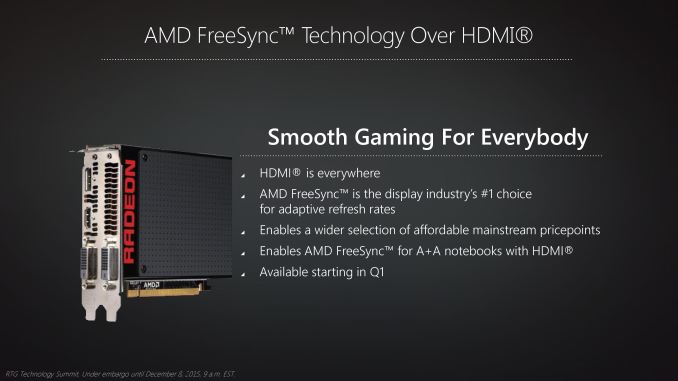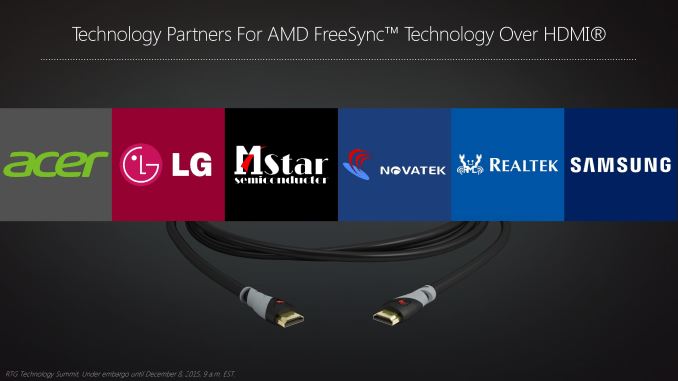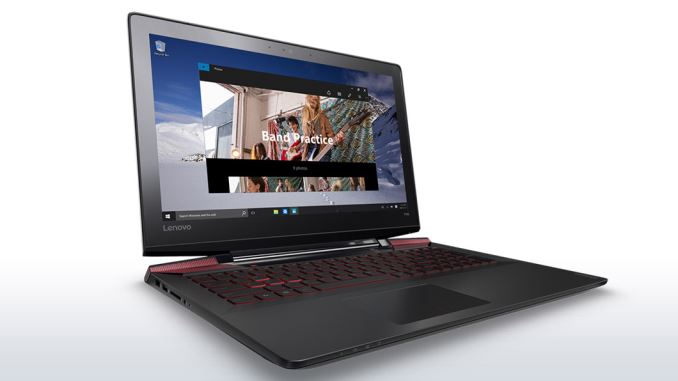AMD Discusses 2016 Radeon Visual Technologies Roadmap
by Ryan Smith on December 8, 2015 9:00 AM EST- Posted in
- GPUs
- Displays
- AMD
- Radeon
- DisplayPort
- HDMI
- Radeon Technologies Group
FreeSync Over HDMI to Hit Retail in Q1’16
After pushing DisplayPort Freesync out the door earlier this year, back at Computex 2015 AMD began demonstrating a further Freesync proof-of-concept implementation: FreeSync over HDMI.
Implemented over a customized version of HDMI 1.4a and utilizing a prototype Realtek timing controller (TCON), AMD was able to demonstrate variable refresh rate technology running over HDMI. At the time of the presentation AMD was very clear that the purpose of the presentation was to shop around the concept and to influence the various members of the HDMI consortium, but they were also clear that bringing variable refresh rate tech to HDMI was something the company wanted to bring to retail sooner than later.
Sooner, as it turns out, was the operative word there. As part of their presentation last week, RTG has announced that FreeSync over HDMI will be heading to retail, and that it will be doing so very soon: Q1’16. This is just a year after the first DisplayPort adaptive sync monitors hit retail, which for a display technology is a rather speedy turnaround from proof of concept to retail product.
Now there are some key technical differences from FreeSync over DisplayPort(FS-DP) that should be noted here. Unlike FS-DP, which was just AMD’s implementation of DisplayPort adaptive sync on their GPUs and software stack, FS-HDMI is not an open standard, at least not at this time. HDMI does not have a variable refresh rate technology standard, and while RTG is pushing to have one included in a future version of HDMI, the HDMI consortium moves too slowly for RTG’s tastes. As a result RTG is looking to go it alone, and will be implementing FS-HDMI by creating a vendor specific extension for HDMI.
The use of vendor specific extensions is perfectly legal within the HDMI standard, but it does mean that FS-HDMI is proprietary, at least until such a time where the HDMI standard adopts a common variable refresh rate standard. This means that FS-HDMI monitors will need to support RTG’s proprietary extensions, which in turn requires TCON/monitor vendors to work a bit more closely with RTG than was necessary with FS-DP. Meanwhile RTG for their part hasn’t yet decided what to do about the proprietary nature of their implementation – they are open to sharing it, but they also want to retain control and avoid any scenario that results in outright balkanization of HDMI variable refresh rate technology. The fact that it’s an RTG-controlled specification calls into question whether any other GPU vendor would want to implement it in the first place – so concerns about openness may prove to be moot – but it does mean that it’s going to be up to RTG to make or break FS-HDMI.
Perhaps more surprising, and certainly a feather in RTG’s cap, is that RTG has brought so many TCON vendors on-board so early. Along with Realtek, Novatek and Mstar will all be producing TCONs that support FS-HDMI, so TCONs will be available from multiple vendors relatively quickly. With variable refresh rate tech it’s the TCONs that really decide whether the tech is supported, so this is an important set of partnerships for RTG to lock in so soon. Meanwhile traditional AMD/RTG display partners such as Acer, LG, and Samsung will be producing retail monitors with FS-HDMI capabilities.
Meanwhile at this point RTG isn’t talking about GPU compatibility in great detail, however it sounds like FS-HDMI support will be brought over to some of RTG’s current GPUs. Most likely these are the GCN 1.1+ Radeon 300 series cards, with GCN 1.1 also being the minimum requirement for FS-DP. AMD’s Carrizo APU should also support the technology, and RTG is specifically promoting that notebooks implementing an APU + dGPU Radeon dual graphics configuration will also support FS-HDMI, an important development especially given the fact that DisplayPort support is non-existent on consumer AMD laptops.
In fact the lack of DisplayPort availability in displays overall is a big part of why RTG has pursued this. According to numbers from RTG, only about 30% of all monitors sold include a DisplayPort, while the other 70% are only implementing HDMI or HDMI + DVI. Consequently FS-DP is an inherently limited market and the majority of monitor buyers will never be able to use FS-DP. Meanwhile from what I hear the actual cost of implementing variable refresh rate support on a TCON is very low, which means that RTG could get far greater penetration for FreeSync by extending it to support HDMI, not to mention bringing down the overall cost of entry-level FreeSync monitors. We’re still talking about a highly price sensitive commodity market – after all, there’s a reason that most monitors don’t ship with a DisplayPort – but if the costs of adding FreeSync are as low as RTG hints, then there is a market for consumers who would spend a bit more on a variable refresh rate monitor but don’t know anything about display I/O standards beyond HDMI.
Finally, along those lines, it should be no surprise that the first FS-HDMI monitors that have been announced are all focused on lower cost and lower resolution displays. That FP-HDMI is being implemented over HDMI 1.4 immediately rules out 4K monitors, so instead all announced monitors are 1080p or ultra-wide 21:9 aspect ratio 2560x1080 and 3440x1440 monitors. Otherwise there are a few more unknowns here that I expect we’ll see addressed ahead of the Q1 launch, particularly which monitors will support a wide-enough range of rates for low framerate compensation to work.
FreeSync Laptops: Shipping Now
Along with the FreeSync over HDMI announcement, RTG also used their event to announce the first FreeSync-capable laptop, the Lenovo Y700. One of the models of the laptop ships with a variable refresh rate capable 15.6” 1080p IPS panel, and when paired up with a Carrizo APU and R9 M380 GPU, can utilize FreeSync to control the refresh rate. The one notable limitation here is that while this otherwise a rather typical DisplayPort adaptive sync setup within a laptop, the specific panel being used here is only supports a range of 40Hz to 60Hz, so the first FreeSync laptop has a narrow effective range and can’t support LFC.
















99 Comments
View All Comments
medi03 - Thursday, December 10, 2015 - link
"while you can find DisplayPort in many monitors, you would be hard pressed not to find HDMI"Try to find HDMI in any g-sync monitor.
BurntMyBacon - Thursday, December 10, 2015 - link
@medi03: "Try to find HDMI in any g-sync monitor."Try to find FreeSync/Adaptive Sync on any g-sync monitor. Given they mutual exclusivity, I'm pretty sure they can simply count these monitors out.
bizude - Thursday, December 10, 2015 - link
Something is funky with the math, or I'm missing information. It says that DP 1.3 will support 3440x1440@190hz, yet based on the bandwidth increase math is telling me the maximum would be 165hz.sheh - Saturday, December 12, 2015 - link
I get 218Hz = DP1.3's 26Gbps bandwidth (32Gbps - overhead) / 3440 / 1440 / 3 (RGB) / 8 (assuming 8-bit color)Harry Lloyd - Friday, December 11, 2015 - link
I would like to see a truthful HDR comparison on actual displays. Those comparison pictures say absolutely nothing. The colors I see on normal displays do not seem dull to me, but maybe it is because I do not know what not dull looks like.johnpombrio - Saturday, December 12, 2015 - link
Reluctant to talk? AMD? They cannot shut up! They have been having press conferences and press releases and ton of PPT slides as fast as they can set them up. The massively overhyped Fury cards was a good example. AMD talked about them for so long that everyone thought that AMD was going to release a blockbuster. When it turned out to be an good card but not what they were promising ("Fastest card on the planet!"), there was a lot of disappointed people.Now we have ZEN MANIA! For a chip that will not be released in volume until 2017, AMD has been hyping it up for over a year now. That will be close to two YEARS of talks, presentations, and even more slides while Intel releases almost 3 generations of chips during the same period.
Those that can, release product. Those that can't, PowerPoint.
geeks - Thursday, December 17, 2015 - link
Really useful blog.It looks impressive.</a href="https://geeksonrepair.com/">Online Computer Repair</a>
quickbunnie - Tuesday, January 26, 2016 - link
For Brandon, the argument that you need a proper viewing environment is imho a straw man argument. None of the image quality factors on either OLED or LCD are really worth looking at in poor viewing environments, other than arguably peak brightness.euskalzabe - Wednesday, July 20, 2016 - link
The HDR discussion of this review was super interesting, but as always, there's one key piece of information missing: WHEN are we going to see HDR monitors that take advantage of these new GPU abilities?I myself am stuck at 1080p IPS because more resolution doesn't entice me, and there's nothing better than IPS. I'm waiting for HDR to buy my next monitor, but being 5 years old my Dell ST2220T is getting long in the teeth...